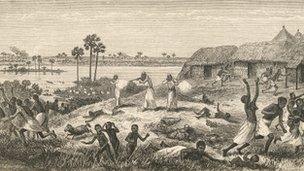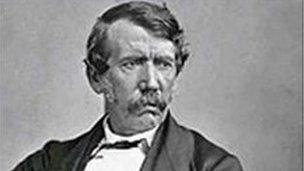Experts shed light on David Livingstone massacre diary
- Published
The diary was treated with light to allow the words to be read
A diary written 140 years ago by Scots explorer David Livingstone can now be read for the first time after experts shed new light on the badly-faded text.
Scientists used spectral imaging to recover the account of the massacre of 400 slaves, which had been written on old newspaper with makeshift ink.
The manuscript, written in central Africa, deteriorated rapidly and is now virtually invisible to the naked eye.
It has gone on show at the National Library of Scotland in Edinburgh.
An international team of experts took part in the 18-month project to uncover Livingstone's personal account of the "unspeakable horror" of the slave trade.
The process involved illuminating the manuscript with successive wavelengths of light. They started with ultraviolet before working through the visible spectrum, ending with infrared.
Processed digital images then enhanced the text.
The pages came from the David Livingstone Centre in Blantyre, which is run by the National Trust for Scotland.
When he wrote the diary, Livingstone had been forgotten by the public and was stranded without supplies in Central Africa.
He was forced to make ink from berry seeds and wrote over the pages of a single copy of the London Standard.

The Massacre of the Manyuema Women at Nyangwe
Curators said it offered a unique insight into Livingstone's mind when he faced the greatest crisis of his last expedition, on which he died.
It also suggests that he altered his original account of the massacre in later journals.
Livingstone recounted the story of the massacre to the journalist HM Stanley - whose report of the deaths forced the British government to close the East Africa slave trade.
Livingstone's diary records him gazing with "wonder" as three Arab slavers with guns entered the market in Nyangwe, a Congolese village where 1,500 people were gathered - most of them women.
He wrote: "50 yards off two guns were fired and a general flight took place - shot after shot followed on the terrified fugitives - great numbers died. It is awful - terrible, a dreadful world this.
"As I write, shot after shot falls on the fugitives on the other side (of the river) who are wailing loudly over those they know are already slain - Oh let thy kingdom come."

Livingstone had been stranded without supplies in Central Africa
However, Dr Adrian Wisnicki, who led the project, said there was evidence in the diary that suggested members of Livingstone's party might have been involved in the massacre.
"Livingstone seems to have considered this possibility and this, together with his failure to intervene, appears to have left him with a profound sense of remorse," said Dr Wisnicki, assistant professor at Indiana University of Pennsylvania and honorary research fellow at Birkbeck College, London.
"In copying over the 1871 diary into his journal, Livingstone decided to rewrite or remove a series of problematic passages.
"It's taken 140 years to discover Livingstone's original words and reveal the many secrets of the original diary."
The Last Journals of David Livingstone (1874) were edited after Livingstone's death in 1873 by his friend Horace Waller.
However, the original account of the massacre, which Dr Wisnicki analysed with contributing editor Dr Debbie Harrison, is one of many passages in the 1871 field diary which was significantly different from the 1874 book.
"Livingstone would never have published this private diary in his own lifetime," says Dr Wisnicki.
"In particular his attitude to the liberated slaves in his entourage is one of disgust - an attitude greatly at odds with his public persona as a dedicated abolitionist."
The National Library of Scotland is home to many of Livingstone's papers, including parts of his African diaries
- Published30 March 2011
- Published2 July 2010